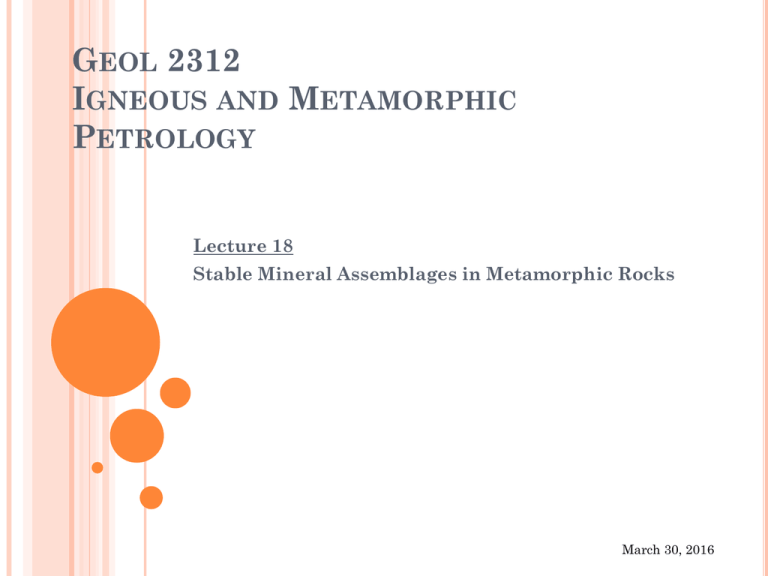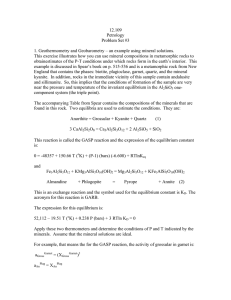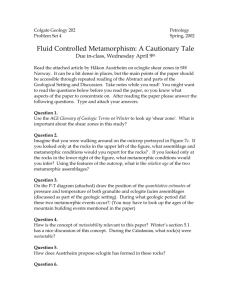G 2312 I M
advertisement

GEOL 2312 IGNEOUS AND METAMORPHIC PETROLOGY Lecture 18 Stable Mineral Assemblages in Metamorphic Rocks March 30, 2016 EQUILIBRIUM MINERAL ASSEMBLAGES Evidence of Chemical Equilibrium - Lack of disequilibrium textures (replacement textures, corona, compositional zoning, ....) - Each mineral type shares contacts with every other mineral phase in the rock - Layers are rare or textures are homogeneous within the layers - Rocks are in textural equilibrium - Rocks conform to Gibbs Phase Rule - Minerals lack chemical zoning PHASE RULE IN METAMORPHIC ROCKS Phase rule, as applied to systems at equilibrium: F=C-f+2 f = the number of phases in the system C = the number of components: the minimum number of chemical constituents required to specify every phase in the system F = the number of degrees of freedom: the number of independently variable intensive parameters of state (such as temperature, pressure, the composition of each phase, etc.) In natural systems, there are multiple compositional variables in addition to independent changes in P & T. If F 2 is the most common situation, then the phase rule may be adjusted accordingly: F = C - f + 2 2, or f C Goldschmidt’s mineralogical phase rule, or simply the mineralogical phase rule PHASE RULE IN METAMORPHIC ROCKS Suppose we have determined C for a rock Consider the following three scenarios: 1) f = C The standard divariant situation of the Phase Rule The rock probably represents an equilibrium mineral assemblage from within a metamorphic zone 2) f < C Common with minerals that exhibit solid solution (e.g., Plagioclase - single mineral, but two components) PHASE RULE IN METAMORPHIC ROCKS 3) f > C A more interesting situation and at least one of three situations must be responsible: A) F < 2 The sample is collected from a location right on a univariant reaction curve (isograd) or invariant point B) Equilibrium has not been attained C) The number of components were not properly chosen PHASE RULE IN METAMORPHIC ROCKS Choosing Components to define Metamorphic Systems As with igneous rocks, it is not reasonable to choose every chemical constituent of a rock as a component. Stick to: - Essential Components that generate a new phase with a limited P&T range (garnet – yes; plagioclase – no) - Three Components (or component combinations) that can be graphically portrayed in 2D Avoid: - Components that are major constituents of single phases (e.g., P2O5 – apatite, TiO2 – ilmenite) - Components that substitute for other components (e.g. Ab-An, Fa-Fo, Mn for Fe, Al for Si, Na for K) - “Perfectly mobile” components (H2O, CO2, ...) PHASE RULE IN METAMORPHIC ROCKS “Perfectly Mobile” H2O or Not Implies that fluid may come and go based on external conditions not controlled by mineral reactions. It is typically not considered a component. It is added as needed and leaves when in excess. Prograde reaction will go regardless if H2O fluid is present Retrograde reaction requires H2O to be present to go, but it is not a component of this system (one comp – MgO) Mg(OH)2 MgO Winter (2001)Figure 24-1. P-T diagram for the reaction brucite = periclase + water. From Winter (2001). An Introduction to Igneous and Metamorphic Petrology. Prentice Hall. PHASE RULE IN METAMORPHIC ROCKS How do you know if you have chosen the proper components? The rocks should tell you The phase rule is an interpretive tool, not a predictive tool, and does not tell the rocks how to behave If you only see low-f assemblages (e.g. Per or Bru in the MgO-H2O system), then some components may be mobile If assemblages have many phases in an area it is unlikely that so much of the area is right on a univariant curve, and may require the number of components to include otherwise mobile phases, such as H2O or CO2, in order to apply the phase rule correctly CHEMOGRAPHIC DIAGRAMS Chemographics refers to the graphical representation of the chemistry of mineral assemblages Mineral compositions possible in a 3component system are plotted on a triangular chemographic diagram COMPONENTS = x, y, and z PHASES = x, y, z, xz, xyz, and yz2 A simple example: the plagioclase system as a linear 2-component plot: CHEMOGRAPHIC DIAGRAMS Compatibility Diagrams determines the equilibrium mineral assemblage that should develop for a particular whole rock composition defined by three components Divariant Equilibrium Mineral Assemblages (A) x-xy-x2z (B) xy-xyz-x2z (C) xy-xyz-y (D) xyz-z-x2z (E) y-z-xyz CHEMOGRAPHIC DIAGRAMS Valid compatibility diagram must be referenced to a specific range of P-T conditions, such as a zone in some metamorphic terrane, because the stability of the minerals and their groupings vary as P and T vary Previous diagram refers to a P-T range in which the fictitious minerals x, y, z, xy, xyz, and x2z are all stable and occur in the groups shown At different grades the diagrams change Other minerals become stable Different arrangements of the same minerals (different tielines connect different coexisting phases) CHEMOGRAPHIC DIAGRAMS W/ SOLID SOLUTION Phases with SS between Y and Z Phases with SS between Y, X. and Z CHEMOGRAPHIC DIAGRAMS W/ SOLID SOLUTION Tie lines link coexisting compositions CHEMOGRAPHIC DIAGRAMS ACF DIAGRAM The three pseudo-components are all calculated on an atomic basis: A = Al2O3 + Fe2O3 - Na2O - K2O C = CaO - 3.3 P2O5 F = FeO + MgO + MnO Best Suited to Mafic Igneous Rocks and Sedimentary Rocks (Graywackes) Figure 24-4. After Ehlers and Blatt (1982). Petrology. Freeman. And Miyashiro (1994) Metamorphic Petrology. Oxford. CHEMOGRAPHIC DIAGRAMS ACF DIAGRAM By creating these three pseudocomponents, Eskola reduced the number of components in mafic rocks from 8 to 3 Water is omitted under the assumption that it is perfectly mobile Note that SiO2 is simply ignored. We shall see that this is equivalent to projecting from quartz In order for a projected phase diagram to be truly valid, the phase from which it is projected must be present in the mineral assemblages represented e.g. Alkali Feldspar CHEMOGRAPHIC DIAGRAMS AKF DIAGRAM A = Al2O3 + Fe2O3 - Na2O K2O - CaO K = K2O F = FeO + MgO + MnO Best Suited to Pelitic (clay-rich) Sedimentary Rocks Projected From Quartz & Plagioclase CHEMOGRAPHIC DIAGRAMS APICAL PHASE PROJECTIONS Mathematically, the same as ignoring CaO in the Di formula and normalizing MgO and SiO2 to 100% Only valid if phase projecting from is present with all phases MgO Per Fo En Di' SiO2 Q CHEMOGRAPHIC DIAGRAMS APICAL PHASE PROJECTIONS Mathematically the same as ignoring SiO2 in the X & Y formulas and normalizing A, B, and C to 100% Possible Phase assemblages (q)-b-x-c (q)-a-x-y (q)-b-x-y (q)-a-b-y (q)-a-x-c x = ABCQ y = A2B2CQ Fig. 24-13



